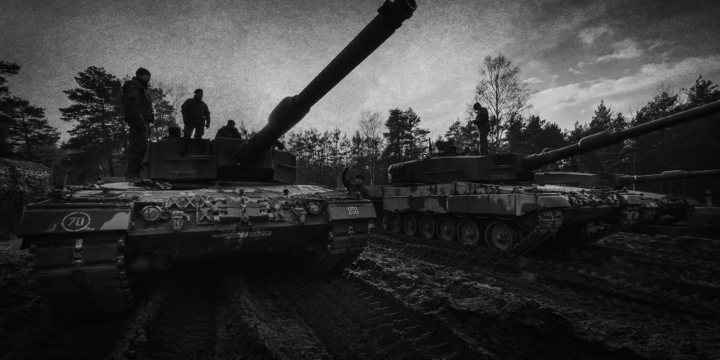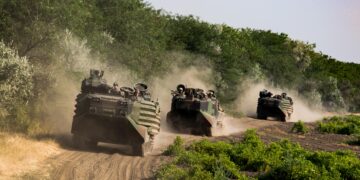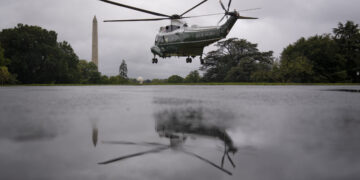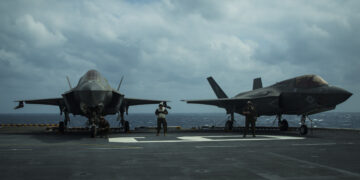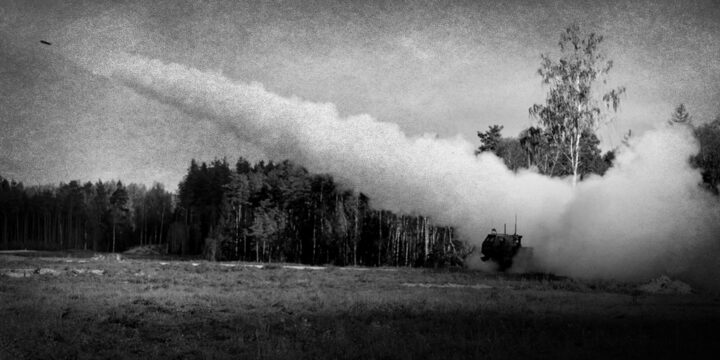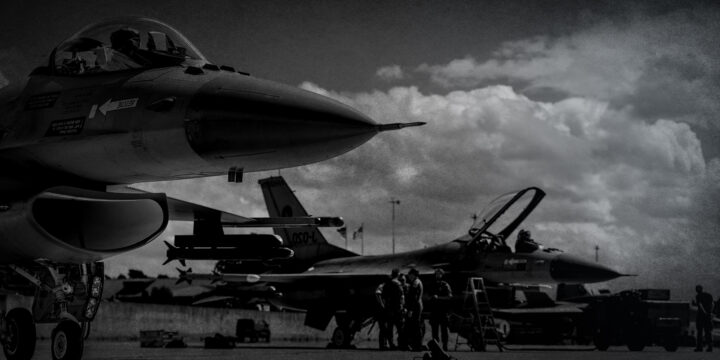June 7, 2022
Hypotheses on the implications of the Ukraine-Russia war
By Barry Posen
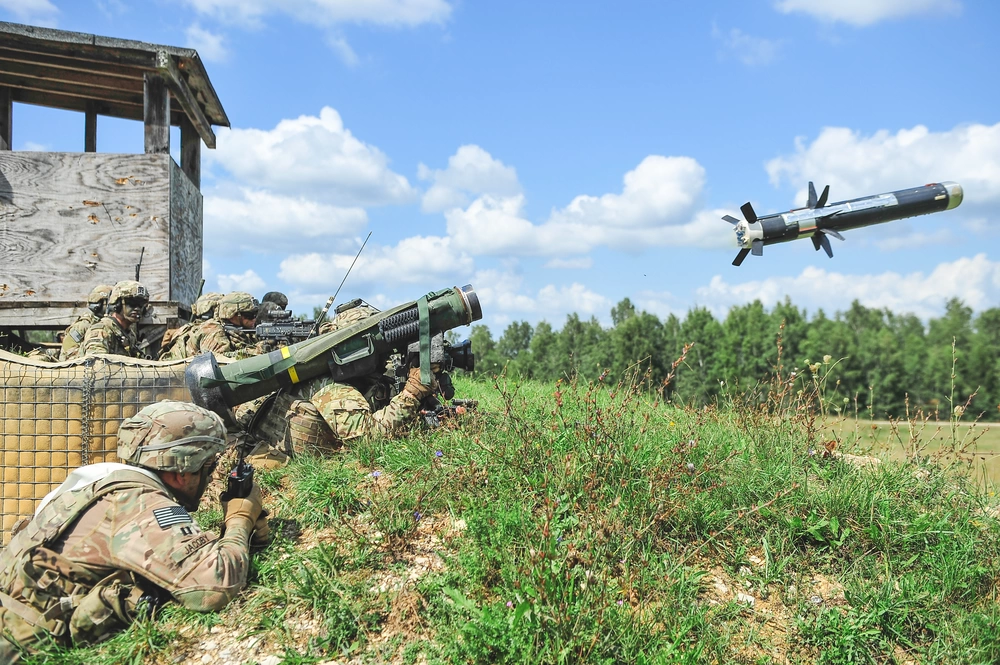
Key points
- Structural realism is a useful tool to examine the implications of the war in Ukraine for global politics.
- Because structural realism emphasizes the anarchic nature of international relations, it suggests the war is unsurprising, a reminder that states still compete for security, sometimes violently, and the prudent will prepare for it with tools for self-preservation.
- The realist lens also sees lessons for nuclear deterrence: The prospect of mutual nuclear destruction constrains great power war and has limited U.S. and NATO support for Ukraine. Other states may take note and seek their own nuclear deterrents.
- The war demonstrates some limits of economic interdependence, which not only failed to pacify Russia, but also left Russia exposed to economic coercion, in a way both it and China may look to avoid in the future.
- Other important lessons for states from a realist perspective include the importance of military power—large, capable armies and the enduring advantages of defensive warfare, especially when infused with nationalism.
- The war leaves the “liberal international order,” a byproduct of the eroding post-Cold War U.S. power position, looking threadbare, but it is thus far reviving the U.S. Cold War coalition—a less liberal grouping—which could prove useful in dealing with China.
Introduction
How will the war in Ukraine shape international politics? In principle there are two ways to address this question. The first is simply to extrapolate into the future any actions or reactions that we can observe today. The second, which is explored below, is to organize our thinking theoretically, to ask what may turn out to be the long-term effects of the major causes set in motion by the war. I organize the discussion below in terms of a theory of international politics—realism, mainly structural realism. Russia’s invasion of Ukraine serves as another reminder that war remains an ever-present danger in an international system that is anarchic—i.e., devoid of any central authority with the wherewithal to protect states from aggression. States must therefore prepare to defend themselves. In the heady aftermath of the liberal West’s victory over the Soviet empire, and the apparent triumph of the U.S.-led, liberal world order, many instead believed that interstate war would become a thing of the past. States now face strong incentives to reembrace tried and tested tools of self-preservation developed in earlier times.
Structural realism—theoretical predictions
Structural realism focuses on the effects of the condition of anarchy, in which all states cohabit.1Kenneth N. Waltz, Theory of International Politics (Reading, MA: Addison-Wesley Publishing Company, 1979), 103–128, https://dl1.cuni.cz/pluginfile.php/486328/mod_resource/content/0/Kenneth%20N.%20Waltz%20Theory%20of%20International%20Politics%20Addison-Wesley%20series%20in%20political%20science%20%20%20%201979.pdf. Without a world government, each nation must look to its own resources to ensure its security. This problem is structural because the actors cannot individually do anything about it. Some aspiring hegemons have tried to change the structure of international politics from anarchy to hierarchy, but these efforts founder on the strong incentives that anarchy presents to individual states to constantly be on guard to protect their independence. Structural realism as a theory is not a rulebook for state policy; its predictive ability does not depend on states understanding the workings of the system as a whole. Its predictive power depends only on the inclination of states to remain autonomous and the “feedback loops” that are produced when some or all states pursue this inclination.
How then ought we describe the current international security structure? It remains anarchic. It is also nuclear, multipolar, and geographically global in structure—these important security facts also cannot be changed by individual states and thus are also elements of structure. In this system, states compete, but the inherent possibility of nuclear escalation—which in the immediate post-Cold War decades some chose to forget—emerges front and center at moments of great power confrontation.
In Kenneth Waltz’s famous phrase, “structures shape and shove.”2Kenneth N. Waltz, “Structural Realism after the Cold War,” International Security 25, no. 1, (Summer 2000): 24, http://www.columbia.edu/itc/sipa/U6800/readings-sm/Waltz_Structural%20Realism.pdf. Anarchy shapes and shoves because it permits the strong to try whatever they wish to try and incentivizes those in the way to react. Anarchy encourages competition, mainly in and about any means that contribute to security.
Competition in its turn produces socialization and emulation. Those who compete too intensively face diplomatic or military pushback. Those who fail to compete at all find themselves under pressure—and subject to threats and demands. To do better the next time, the active and the inattentive recoil from these behaviors. “Cautious” competition is the path to survival.
The condition of anarchy makes war the central concern of states. Structural realism thus suggests that great and middle powers “take notice” when any other great power is at war.3Perhaps the most striking reversal of course prompted by the war is that of the Federal Republic of Germany, which has finally committed to achieve NATO’s goal of 2 percent of GDP allocated to defense and has backed that commitment with a 100 billion Euros of emergency funding. See Sabine Kinkartz, “German Chancellor Olaf Scholz Announces Paradigm Change in Response to Ukraine Invasion,” Deutsche Welle, February 27, 2022, https://www.dw.com/en/german-chancellor-olaf-scholz-announces-paradigm-change-in-response-to-ukraine-invasion/a-60932652. War can alter international power relationships and reveal information about capabilities.4Waltz, Theory of International Politics, 103–128.
In a competitive system, states emulate successful practices because that is the least expensive way to remain competitive. Innovation is hard and risky; emulation of proven successful practices is the more economical course. Emulation is particularly common in the military realm. Whenever any great powers are at war with lesser states or with other great powers, the bystanders watch them carefully for evidence of military innovations and clues to how to compete.5Waltz, Theory of International Politics, 127.
In a competitive system, states also avoid becoming too dependent on external sources of support, especially military support. At the same time, some degree of dependence is often unavoidable. In the pre-nuclear, multipolar world, great powers had no choice but to depend on their great power allies, even though they found this dependence irksome.6Robert Jervis, The Meaning of the Nuclear Revolution: Statecraft and the Prospect of Armageddon (Ithaca, NY: Cornell University Press, 1990). The simple arithmetic of coalitions meant any state that decided to go it alone could find itself outweighed by any two-state partnership. Rare circumstances allowed a great power to insulate itself from the coalition game, but not forever. In this game, even a prudential coalition was often viewed suspiciously by those in its penumbra. Nuclear weapons have made it a good deal easier for states to go it alone, even in a multipolar world. But allies are still worth something to those facing major security problems.
Realist predictions about the effects of the Ukraine-Russia war
Possible effects at the state level
Something can perhaps be learned by viewing the Ukraine-Russia war through the structural realist lens. What ripple effects does the theory suggest the war may produce?
The first effect is the most obvious. All have been reminded that world politics remains kinetically competitive. The potential for war—interstate war—is real. It was tempting to believe otherwise in the years after the Cold War. True, interstate war has been rare in recent years. True, though Russia is a great(ish) power, Ukraine is not. Great power war still seems unlikely, especially among nuclear armed great powers. It simply seems a great deal less unlikely than it did a few months ago. That is likely enough to get attention.
The second effect is renewed concern about dependence and an accompanying skepticism about the extent to which economic interdependence can reduce crises and wars. The debate about China’s rise for perhaps the last decade revealed a growing skepticism about whether trade and economic development can affect intentions of states in a positive direction faster than they change the distribution of relative capabilities among them in ways that increase the probability of conflict. The COVID-19 pandemic raised questions about the fragility of tightly knit global supply chains and how dependence on imports left even great states short of key products and increased their sense of insecurity. The Ukraine-Russia war has magnified all these concerns. Russia managed to create a glittering military shop window, in part by buying necessary subcomponents of IT intensive weaponry, communications, and surveillance technology abroad. The war may demonstrate that, at least for an aspiring great power, this path is unwise. Even if wise, the path suggests states must buffer themselves against technological and other kinds of dependencies. Russian planners seem to have thought that big bank accounts and others’ dependency on their energy exports would shield them from economic pressure. Though they are certainly better off than most, they will have problems sustaining even the moderate quality of the weaponry they have employed now that that they face frightened suppliers. The lesson that observers may draw is “depend little, buffer much.”
Great powers and great power aspirants, and indeed even small countries with big security problems, watch big wars carefully. They look for lessons even though they sometimes misinterpret them. Some big candidate lessons jump out from this war. The first is that non-nuclear fighting power still counts, and it isn’t cheap. It is apparent that Russia cut corners rebuilding its conventional fighting power in both personnel practices and capital investments. They can perhaps remedy their personnel problems to some extent by a return to their old “mass army” practices. It is quite likely they will need to rely on conscripts and mobilized reservists heavily if they are to succeed even in their now limited aims in the war, and some reports suggest they are now calling up some reservists.7Liz Sly, “Pro-War Russians Are Increasingly Critical of the Ukraine Conflict,” Washington Post, May 19, 2022, https://www.washingtonpost.com/world/2022/05/19/russians-criticize-military-war-ukraine/.
Military conscription policy by country
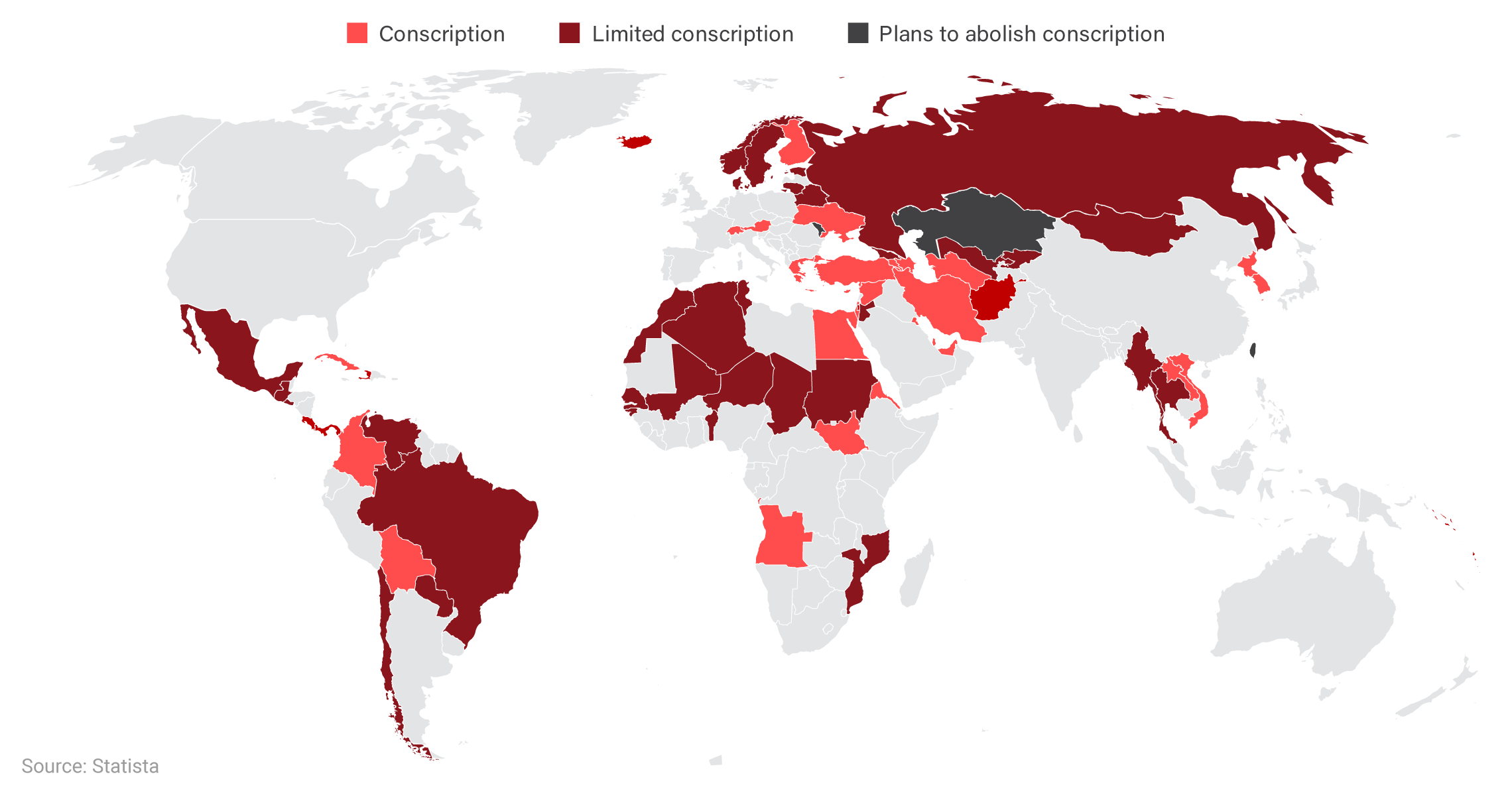
Countries that have abolished or are considering abolishing conscription may rethink that decision in light of the war in Ukraine.
Ukraine’s experience is equally revealing. Well-trained and well-armed forces fighting on defense can impose significant costs on an attacker, especially a poorly prepared one. That said, Ukraine would have done much better had it taken the Russian threat even more seriously. And they would have done a good deal less well had Russia been better prepared. To the naked eye Ukraine has undergone a spontaneous and rather speedy “levee en masse” with modern features. Ukraine had conscription as an institution but conscripted only small numbers and did not train their conscripts for war, instead confining their service to support units. The burden of the fighting thus far has fallen on a relatively small share of Ukraine’s population who volunteered for combat units. Now, Ukraine is scrambling to train many more people for war. Those states that have given up conscription may rethink that decision. Those who are contemplating giving it up may change their minds.8For more on moves away from conscription in Europe see Curtis Gilroy and Cindy Williams, Service to Country: Personnel Policy and the Transformation of Western Militaries (Cambridge, MA: MIT Press, 2006). The strategic situation of the U.S. allows it to ignore this lesson, but most others may sense their all-volunteer armies are too small or brittle for the demands of modern war.9Most European countries abandoned conscription after the end of the Cold War, including Sweden. Finland was a notable exception. But prompted by rising tensions in Europe, Sweden reinstituted conscription in 2018. See “Sweden Brings Back Military Conscription Amid Baltic Tensions,” BBC, March 2, 2017, https://www.bbc.com/news/world-europe-39140100.
Allied to the narrowly military lesson of the war is a larger political or bureaucratic lesson. This too dovetails with conclusions some may have drawn from the COVID-19 pandemic. Society itself must be better prepared for war. Ukraine has managed to improvise civil defense measures, evacuation procedures, and economic management tools for a “World War II” experience. Among developed countries, Finland may be the only one in Europe to have more or less maintained all these capacities. Others may emulate the Finnish model.
Nationalism has been closely connected to the mobilization of administrative, military, and economic power since the French Revolution.10Barry R. Posen, “Nationalism, the Mass Army, and Military Power,” International Security 18, no. 2, (Fall 1993): 80–124, https://www.jstor.org/stable/2539098. Resurgent nationalism worldwide has been viewed as an unhappy evolution over the last several decades. But Ukrainian nationalism has clearly been an important tool of successful resistance. Russian President Vladimir Putin knows this very well, which is why he has been forced to play the same nationalist card to mobilize the Russian people to make the sacrifices that will be necessary to defeat the Ukrainians and endure sanctions. Other states and their leaders may take note, providing another impetus to resurgent nationalism.
U.S. sanctions by country
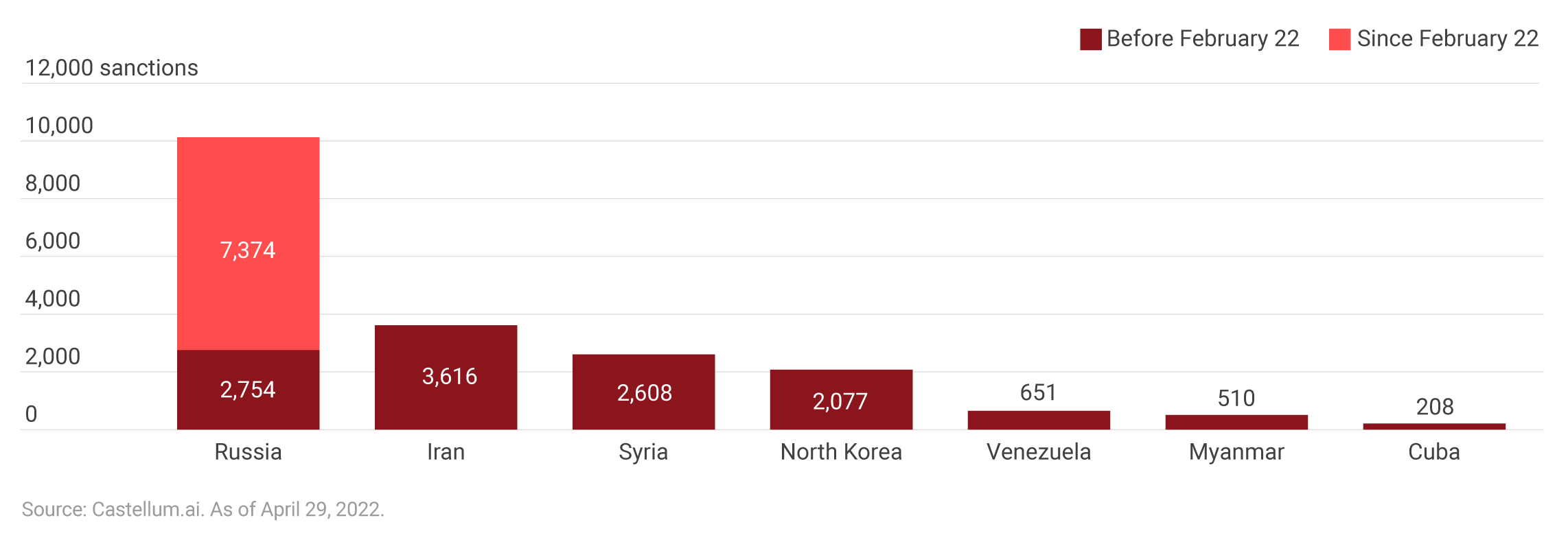
Russia has paid a heavy economic price for its invasion of Ukraine. In the months immediately following the invasion, the United States unleashed a series of sanctions on Russia that nearly surpassed the total number of sanctions the U.S. imposes on every other country combined. Even still, Russia persists in the name of defending its sphere of influence.
Possible effects at the international level
Thus far, I have mainly discussed the possible shaping and shoving at the state level that may be precipitated by this singular event. We are also seeing some effects at the “international” level, where states relate to one another. Three patterns are noteworthy.
Though the U.S. has managed to tighten and revive its Cold War victory coalition, those countries who valued their independence and autonomy in that struggle continue to do so. India and China are at odds with one another and have very different political systems. Yet each prefers to maintain good relations with wayward Russia. A realist expects this. Uncomfortable though each may be with Russian policy, and with the attention a neutral posture draws to them, the resurgence of Russia as a great power gave them cards to play in their relations with the United States, and probably with each other. They would rather not see Russia suffer a truly crushing defeat. Keeping a valuable player alive is characteristic of multipolar competitive systems.
The great(ish) powers seem inclined to protect their freedom of maneuver, but the less great are now more strongly incentivized to seek protection. Finland and Sweden did well as neutrals during the Cold War, but strikingly, they seem disinclined to try the same strategy a second time, even versus a Russia much reduced from its Cold War power. Ukraine’s military performance has depended greatly on western—especially U.S.—weaponry, intelligence, and finance. It is also clearer than clear that membership in NATO, the Cold War military alliance, puts one under the U.S. “nuclear umbrella,” and however much support Ukraine gleans from its very friendly relationship with the United States, Ukraine would have been better off yet had it somehow already snuck under the nuclear umbrella. It is one thing for the United States to send swords, it is quite another for it to send the cavalry, which it only does when all the alliance ties are well cemented and there has been a lot of time to build the edifice of a credible nuclear commitment. The recent outpouring of support for Ukraine has obscured the fact that it was not in NATO because many of the European members of NATO did not want to be implicated in Ukraine’s quarrels, and it was not in the U.S. interest to argue the point very strongly with its allies. The flip side is those that do not or cannot get into a well institutionalized alliance with the United States, and that fear aggression by a nuclear adversary, will more than ever covet their own nuclear weapons. The experience of the war in Ukraine will thus be a complicating factor in non-proliferation policy.
The notion of “spheres of influence” figured prominently in the U.S. debate about whether Russia ought to have been granted some say on NATO’s open-door policy, as it related to Ukraine and Georgia. Advocates of a “rules-based, liberal world order” condemn the idea that a great power has any say over the foreign or domestic policy of a neighboring small power, just because it is a great power. Small states must have agency, they aver. No spheres of influence would be conceded. This policy is unlikely to change, at least outwardly. Yet when the history is written, the unwillingness of the United States to consider, let alone concede, a sphere of influence to Russia will likely figure as an important contributing cause of this war.11Stephen Van Evera, “To Prevent War and Secure Ukraine, Make Ukraine Neutral,” Defense Priorities, February 19, 2022, https://www.defensepriorities.org/explainers/to-prevent-war-and-secure-ukraine-make-ukraine-neutral; Ryan Evans, “A Conversation with the Counselor: Derek Chollet on Navigating the World,” April 13, 2022, War on the Rocks, podcast, mp3, 43:01, April 13, 2022, https://warontherocks.com/2022/04/a-conversation-with-the-counselor-derek-chollet-on-navigating-the-world/.
Presently, this view is banished to the margins of public discourse on the war, but it is likely that many key participants would, if privately pressed, accept it, if only in part. Open agreement on “spheres” is not likely to become a policy of the United States or its allies. But private understanding of “spheres of interest” may exert a subtle influence. This is especially true given what we have relearned about confrontation between nuclear powers. The U.S. has been chary of bringing its own military power to bear in this war because it retains a healthy fear of nuclear escalation. Nuclear confrontations are typically contests of will. It is simply the case that states care more about what happens in their side and back yards than do their opponents farther afield. We know that Russia cares more about the Donbas than we do, and that is one reason we don’t wish to fight them there. Statespersons may not wish to concede spheres of influence, but they will still need a set of policies that capture the connection between geography, interest, and nuclear deterrence.
Speculations on policy
The United States has always had a good geographic “position” in international politics, and since the late 19th century rise of its economy, its security position has been excellent. Along with nuclear weapons and sea power, the United States can now “take as much or as little of the war” as it wishes.12Francis Bacon, c. 1600, https://www.laphamsquarterly.org/contributors/bacon. For 30 years, it has wanted more of the war than I and a few friends of mine have thought wise.
The Ukraine war will provide a fillip to U.S. activism, as the Europeans seek inexpensive security insurance from the United States and U.S. policymakers succumb to the temptations of invitational hegemony, if only confined to certain regions. At the same time, the notion of a U.S.-led, rules-based, liberal world order is looking pretty threadbare. That intellectual construct was founded on a unipolar structure of power that no longer exists. Instead, we see the reemergence of the U.S.-led Cold War coalition. (That coalition is largely liberal, but often hypocritically tolerant of vicious authoritarians within its own ranks.) Even before the war in Ukraine, the United States hoped to resurrect said coalition and, despite its trans-Atlantic core, direct it at China. This seemed like it would have been very difficult. But Russia’s aggression has energized the Cold War coalition and stimulated its muscle memory, and China’s tacit support of Russia has alerted Europeans to the dangers China might pose. Though the coalition is getting back into shape tilting with a somewhat weakened Russia, this fight is still exercise. A counter-China tool is falling into the U.S. lap courtesy of Russia’s strategic overreach.
On the other side of the ledger, a weakened Russia aligned with China makes for a less imposing coalition than the pair presented just a few months ago. Chinese behavior may be a bit more judicious not only because it has “seen” what comes from bold bids for advantage, but also because its only major partner is weaker than it was. Wolf warrior diplomacy stems from many domestic sources, and a structural realist should be modest about the prospects of “socializing” China into more cautious behavior. Great powers do not always profit from the lessons offered them.
Endnotes
- 1Kenneth N. Waltz, Theory of International Politics (Reading, MA: Addison-Wesley Publishing Company, 1979), 103–128, https://dl1.cuni.cz/pluginfile.php/486328/mod_resource/content/0/Kenneth%20N.%20Waltz%20Theory%20of%20International%20Politics%20Addison-Wesley%20series%20in%20political%20science%20%20%20%201979.pdf.
- 2Kenneth N. Waltz, “Structural Realism after the Cold War,” International Security 25, no. 1, (Summer 2000): 24, http://www.columbia.edu/itc/sipa/U6800/readings-sm/Waltz_Structural%20Realism.pdf.
- 3Perhaps the most striking reversal of course prompted by the war is that of the Federal Republic of Germany, which has finally committed to achieve NATO’s goal of 2 percent of GDP allocated to defense and has backed that commitment with a 100 billion Euros of emergency funding. See Sabine Kinkartz, “German Chancellor Olaf Scholz Announces Paradigm Change in Response to Ukraine Invasion,” Deutsche Welle, February 27, 2022, https://www.dw.com/en/german-chancellor-olaf-scholz-announces-paradigm-change-in-response-to-ukraine-invasion/a-60932652.
- 4Waltz, Theory of International Politics, 103–128.
- 5Waltz, Theory of International Politics, 127.
- 6Robert Jervis, The Meaning of the Nuclear Revolution: Statecraft and the Prospect of Armageddon (Ithaca, NY: Cornell University Press, 1990).
- 7Liz Sly, “Pro-War Russians Are Increasingly Critical of the Ukraine Conflict,” Washington Post, May 19, 2022, https://www.washingtonpost.com/world/2022/05/19/russians-criticize-military-war-ukraine/.
- 8For more on moves away from conscription in Europe see Curtis Gilroy and Cindy Williams, Service to Country: Personnel Policy and the Transformation of Western Militaries (Cambridge, MA: MIT Press, 2006).
- 9Most European countries abandoned conscription after the end of the Cold War, including Sweden. Finland was a notable exception. But prompted by rising tensions in Europe, Sweden reinstituted conscription in 2018. See “Sweden Brings Back Military Conscription Amid Baltic Tensions,” BBC, March 2, 2017, https://www.bbc.com/news/world-europe-39140100.
- 10Barry R. Posen, “Nationalism, the Mass Army, and Military Power,” International Security 18, no. 2, (Fall 1993): 80–124, https://www.jstor.org/stable/2539098.
- 11Stephen Van Evera, “To Prevent War and Secure Ukraine, Make Ukraine Neutral,” Defense Priorities, February 19, 2022, https://www.defensepriorities.org/explainers/to-prevent-war-and-secure-ukraine-make-ukraine-neutral; Ryan Evans, “A Conversation with the Counselor: Derek Chollet on Navigating the World,” April 13, 2022, War on the Rocks, podcast, mp3, 43:01, April 13, 2022, https://warontherocks.com/2022/04/a-conversation-with-the-counselor-derek-chollet-on-navigating-the-world/.
- 12Francis Bacon, c. 1600, https://www.laphamsquarterly.org/contributors/bacon.
Author

Barry
Posen
Ford International Professor of Political Science, Security Studies Program
Massachusetts Institute of Technology
More on Eurasia

By Dan Caldwell
July 6, 2025
Featuring Jennifer Kavanagh
July 3, 2025
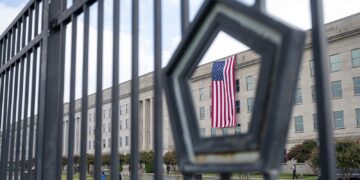
Featuring Jennifer Kavanagh
July 3, 2025
Events on Ukraine-Russia
